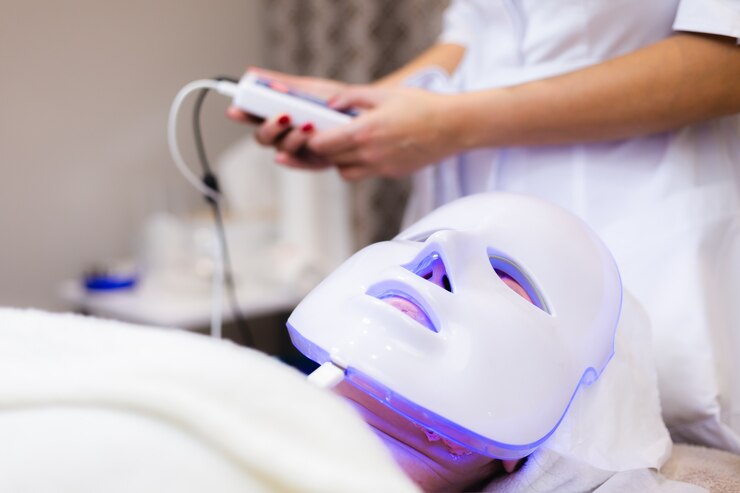LED Light Therapy

LED light therapy is a non-invasive skincare treatment that uses various wavelengths (colors) of light to address a variety of skin concerns. This treatment is popular for its ability to improve skin health and appearance with minimal to no downtime. LED stands for Light Emitting Diode, and it works by emitting light energy into the skin at different depths, stimulating various cellular processes.
How LED Light Therapy Works:
LED light therapy uses different colors of light to penetrate the skin at varying depths, each color targeting specific skin concerns. The light energy is absorbed by skin cells, triggering various biological processes that can help heal, regenerate, and rejuvenate the skin.
Types of LED Light Used in Therapy:
Red Light:
- Wavelength: 620–750 nm.
- Benefits: Red light penetrates deeper into the skin and stimulates collagen production. It is effective for reducing the appearance of fine lines, wrinkles, and sagging skin. It can also improve skin texture and tone by promoting cell turnover.
- Best for: Aging skin, fine lines, wrinkles, and overall skin rejuvenation.
Blue Light:
- Wavelength: 405–420 nm.
- Benefits: Blue light targets the surface of the skin and is primarily used for its antibacterial properties. It helps kill acne-causing bacteria and can reduce inflammation associated with acne. It also helps regulate oil production in the skin.
- Best for: Acne, oily skin, and blemishes.
Green Light:
- Wavelength: 525–550 nm.
- Benefits: Green light is known for its calming and soothing effects on the skin. It helps reduce pigmentation issues, such as sun spots, melasma, and hyperpigmentation, by targeting melanin production. It also helps balance skin tone and reduce redness.
- Best for: Hyperpigmentation, sunspots, and redness.
Yellow Light:
- Wavelength: 590–620 nm.
- Benefits: Yellow light helps reduce skin redness and irritation, and it promotes skin healing. It is also known to improve skin elasticity and tone by stimulating circulation and promoting the production of collagen and elastin.
- Best for: Reducing redness, boosting skin radiance, and improving skin tone.
Purple Light:
- Wavelength: A combination of red and blue light.
- Benefits: Purple light combines the benefits of red and blue light. It helps with skin healing, rejuvenation, and acne treatment by targeting both bacteria and collagen production.
- Best for: Acne and anti-aging.
Infrared Light:
- Wavelength: 750–1200 nm.
- Benefits: Infrared light reaches the deepest layers of the skin and tissues. It helps with cellular repair, reduces inflammation, and promotes overall healing and regeneration.
- Best for: Deep tissue healing, reducing inflammation, and improving circulation.
Benefits of LED Light Therapy:
- Anti-aging effects: Reduces the appearance of fine lines, wrinkles, and sagging skin by stimulating collagen and elastin production.
- Acne treatment: Blue light kills acne-causing bacteria, while red and yellow lights help reduce inflammation and promote skin healing.
- Improves skin texture and tone: Helps promote cell turnover, reduce redness, and even out skin tone.
- Non-invasive: LED therapy doesn’t involve needles, cuts, or harsh chemicals, making it a gentle option for all skin types.
- Minimal to no downtime: There’s no recovery time after the treatment, and patients can resume their normal activities immediately.
Treatment Process:
- Cleansing: Your skin is thoroughly cleansed to remove any dirt, oils, or makeup.
- Application of LED Lights: Depending on the type of LED light therapy being used, a professional or at-home device will be placed close to your face. You may be asked to relax and close your eyes during the treatment, as the light can be quite bright.
- Treatment Duration: A typical session lasts between 15 to 30 minutes, depending on the type of therapy and the specific goals.
- Post-Treatment Care: After the session, you can usually go back to your regular skincare routine immediately, but it’s important to apply sunscreen as the skin may be more sensitive after the treatment.
Frequency of Treatment:
- Initial Phase: To see optimal results, a series of treatments is often recommended. This typically involves 2-3 sessions per week for 4–6 weeks.
- Maintenance Phase: After the initial treatments, maintenance sessions may be recommended once a month or as needed to maintain results.
Possible Side Effects:
LED light therapy is generally safe, with very few side effects. However, some individuals may experience:
- Mild redness or irritation: This is usually temporary and subsides quickly after treatment.
- Eye discomfort: Some people may feel discomfort from the bright light, which is why protective goggles are often provided during treatments.
Who Should Avoid LED Light Therapy:
While LED light therapy is safe for most people, some individuals should exercise caution or avoid it altogether:
- Pregnant individuals: While there’s no evidence of harm, some practitioners may recommend avoiding LED light therapy during pregnancy.
- Individuals with light-sensitive conditions: If you have a condition that makes your skin sensitive to light (such as lupus or certain photosensitivities), it’s important to consult a healthcare professional before starting treatment.
- Those on certain medications: Some medications, like certain antibiotics or acne treatments, can make the skin more sensitive to light.
At-Home vs. Professional LED Treatments:
- At-Home Devices: There are a variety of handheld or face masks available for home use. These are typically less powerful than professional devices but can be used regularly for ongoing skin maintenance.
- Professional LED Treatments: Offered at spas or dermatology clinics, these treatments use more powerful devices and can provide quicker, more noticeable results, especially for specific skin concerns like acne or advanced signs of aging.
